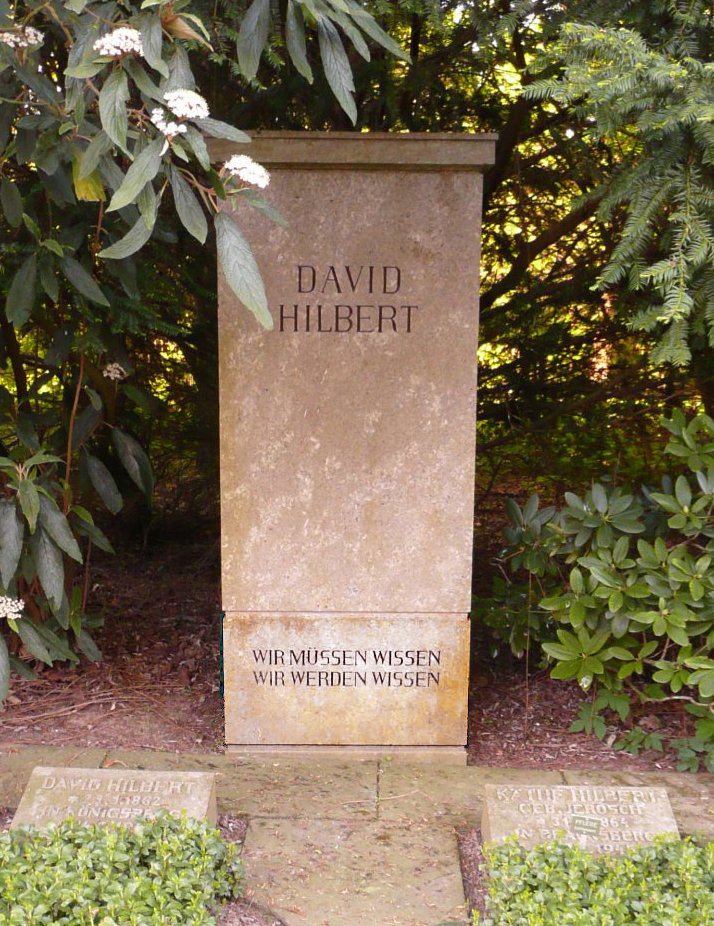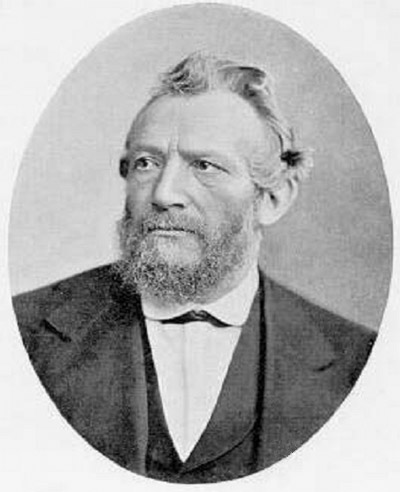- About MAA
- Membership
- MAA Publications
- Periodicals
- Blogs
- MAA Book Series
- MAA Press (an imprint of the AMS)
- MAA Notes
- MAA Reviews
- Mathematical Communication
- Information for Libraries
- Author Resources
- Advertise with MAA
- Meetings
- Competitions
- Programs
- Communities
- MAA Sections
- SIGMAA
- MAA Connect
- Students
- MAA Awards
- Awards Booklets
- Writing Awards
- Teaching Awards
- Service Awards
- Research Awards
- Lecture Awards
- Putnam Competition Individual and Team Winners
- D. E. Shaw Group AMC 8 Awards & Certificates
- Maryam Mirzakhani AMC 10 A Awards & Certificates
- Two Sigma AMC 10 B Awards & Certificates
- Jane Street AMC 12 A Awards & Certificates
- Akamai AMC 12 B Awards & Certificates
- High School Teachers
- News
You are here
David Hilbert's Radio Address - Hilbert and Mathematical Inquiry
As he read his 1930 radio address, the mathematician David Hilbert (1862-1943) assumed that his listeners were familiar with many philosophical ideas and arguments that formed the foundation of German intellectual life, including some which played major roles in the development of mathematics. Was his assumption justified?
The historian David E. Rowe recently gave a sweeping but succinct explanation (Rowe 2013, 38)
... that pertains to the rise of higher mathematics in the German universities during the course of the nineteenth century … . [T]hese mathematicians were accustomed to pondering philosophical questions. Indeed, as members of the Bildungsbürgertum—the ‘educated citizenry’ who formed a special elite class within German society—philosophizing in the academic sense of the term was a natural part of their collective cultural identity.
Hilbert belonged to that culture. His 1885 minor doctoral thesis, for example, was a defense of the view of Königsberg’s most illustrious son, the eighteenth-century philosopher Immanuel Kant (1724-1804), that arithmetic is founded on a priori knowledge, not derived from experience (Reid 1970, 17). The borderline between inborn and experiential knowledge was disputed long before Kant’s time and has been disputed ever since. Hilbert began his radio address by noting that mathematics provides the means to connect the two realms.
An earlier foray into this murky interface had been undertaken by the noted Berlin physiologist Emil Du Bois-Reymond (1818-1896) in an 1872 speech presented to the Society of German Natural Scientists and Physicians (Du Bois-Reymond [1872] 1874 [note 1]). Du Bois-Reymond's investigations of electrical properties of the nervous system had led him to long-standing fundamental questions, especially the nature of matter and force and the relationship between mental phenomena and their physical aspects. He recognized scientists’ general belief that when we do not know a solution—ignoramus in Latin—nevertheless, under certain circumstances, we could know. However, he countered, concerning riddles of the material world such as these two, we must decide in favor of a harder truth: ignorabimus—we shall never know. Du Bois-Reymond reported later that his 1872 speech had excited considerable controversy and his ignorabimus slogan had become a sort of shibboleth in natural philosophy. To clarify misunderstandings, he specified in more detail the questions to which it should apply in a speech delivered in 1880 (Du Bois-Reymond 1880, 1046, 1053–1057). Hilbert would have become very familiar with such controversy during his student years at Königsberg (Reid 1970, 13).
|
|
|
|
| Emil Du Bois-Reymond circa 1885 (Source: Project Gutenberg) |
David Hilbert in 1886 (Source: Wikimedia Commons) |
Hilbert remained at the University of Königsberg for the first part of his career, rising through the ranks to full professor. His research concentrated on algebraic geometry and algebraic number theory: abstract mathematics at the highest level. He moved to the University of Göttingen in 1895 and helped make it the world’s leading center for mathematical research. During the 1890s he applied algebraic methods to establish solid foundations for the geometry that is familiar to high-school teachers and students. By 1900 he was recognized as the leading German research mathematician.
The 1900 Universal Exposition in Paris celebrated the beginning of a new century of industrial and scientific progress. The International Congress of Mathematicians met there concurrently and Hilbert presented a now famous lecture on outstanding open problems in mathematics. In his introduction he took explicit issue with the philosophy emphasized by Du Bois-Reymond thirty years before (Hilbert [1900] 1902, 444–445):
Occasionally it happens that we seek the solution under insufficient hypotheses or in an incorrect sense, and for this reason do not succeed. The problem then arises: to show the impossibility of the solution under the given hypotheses, or in the sense contemplated. ... It is probably this important fact along with other philosophical reasons that gives rise to the conviction (which every mathematician shares, but which no one has as yet supported by a proof) that every definite mathematical problem must necessarily be susceptible of an exact settlement, either in the form of an actual answer to the question asked, or by the proof of the impossibility of its solution and therewith the necessary failure of all attempts. ... This conviction of the solvability of every mathematical problem is a powerful incentive to the worker. We hear within us the perpetual call: There is the problem. Seek its solution. You can find it by pure reason, for in mathematics there is no ignorabimus.
Hilbert’s career during the next decades was characterized by major research on new problems—integral equations, mathematical physics, and establishment of a sound logical foundation for mathematics via finitistic reasoning. (For more information about the latter, see, for instance, "Hilbert's Program" in the Stanford Encyclopedia of Philososophy.) And he practiced entrepreneurship on behalf of mathematical research and the program at Göttingen, including continued outreach to general audiences. He took many opportunities to emphasize the philosophy stated in his famous address of 1900. (See Hilbert [1922–1923] 1988, 132, and Hilbert [1925] 1969, 384, for instance.)

Königsberg in the 1930s. Six of the seven bridges of the famous Königsberg bridges problem (see Steinhaus [1950] 1983, 256–259) are visible in the photograph above. The seventh stands just beyond the photograph, on the lower right. Königsberg was the capital of East Prussia, Germany, until 1945, when it came under Soviet control. The Soviets renamed it Kaliningrad, and it remains part of the Russian Federation today. It is in an enclave of Russia, separate from the rest of that country and surrounded by Poland, Lithuania, and the Baltic Sea. (Source: Ostpreussen.net)
As he approached retirement in 1930, Hilbert’s home city of Königsberg planned to honor him, and he prepared to respond with an address about the nature of mathematical inquiry. There would be a large audience in Königsberg at the beginning of September, as four German professional societies related to his work would be meeting together. The area around the University and Rathaus, shown in the photograph above, would be crowded with mathematicians, philosophers, and scientists. Hilbert chose to address the meeting of the Society of German Natural Scientists and Physicians, probably because the ignorabimus slogan that he would discredit had originated at its meeting nearly six decades before. Another factor in his decision may have been that in 1922, to celebrate Hilbert's sixtieth birthday, that Society's journal had published an entire issue devoted to his colleagues' accounts of his life and work (Naturwissenschaften 10, issue 4) [note 2].
Hilbert’s presentation opened the fourth day of the September 1930 meetings in Königsberg. His full text was published in the December 1930 issue of the broadly circulated journal Natural Sciences (Naturwissenschaften; Hilbert [1930] 1996). The structure of Hilbert’s speech was similar to that of Du Bois-Reymond’s 1872 speech, but its tone was more optimistic, reflecting accelerating scientific progress. The climactic final lines of the two speeches, even in choice of language, offer stunning contrast:
| Du Bois-Reymond 1872: | Hilbert 1930: | Wir müssen wissen. | |
| Ignorabimus. | Wir werden wissen. |
Hilbert's radio address took place very soon after his speech at the Königsberg meeting. Hilbert's biographer Constance Reid interviewed Kurt Reidemeister (1893-1971), who had accompanied Hilbert to the studio (Reid 1970, 196; 1999). A recording of the radio address on a 45-rpm record disk accompanied the original 1971 edition of Reidemeister's Hilbert Gedenkband (Hilbert Memorial Volume), but was not included with the first printing of the 2012 reissue of this volume.
Besides the meeting of the Society of German Natural Scientists and Physicians, the other three conferences at Königsberg in early September of 1930 were
- Second Conference on Epistemology of the Exact Sciences,
- Annual Meeting of the German Mathematical Society, and
- Annual Meeting of the German Physical Society.

David Hilbert's gravestone in Göttingen, Germany
(Source: Wikimedia Commons)
The first of these was the most momentous of the four, a major step in bringing the adherents of the Vienna Circle of philosophers to both inner agreement and public notice. Their program challenged and eventually helped supplant much of the type of philosophy discussed and developed in the German universities in the late 19th and early 20th centuries. On September 6, two days before Hilbert’s speech, the young Austrian logician Kurt Gödel (1906-1978) presented his completeness theorem, which filled a major gap in Hilbert’s finitist foundation of mathematics. In a round-table discussion on the next day, the day before Hilbert spoke, Gödel modestly announced his first incompleteness theorem. (See Wang 2005, 85–86, which also points out that Hilbert and Gödel evidently never met directly.) Gödel’s incompleteness theorem entailed the impossibility of Hilbert’s proposed solution of the foundations problem. In a 1999 article vividly describing Hilbert’s address, Victor Vinnikov concentrated on this aspect of its legacy [note 3]. For a yet deeper, broader, and extremely effective treatment of these questions, see the 2005 book by Torkel Franzén.
Hilbert died in 1944. His famous slogan
Wir müssen wissen
Wir werden wissen
forms the epitaph on his gravestone.
Notes
1. Emil Du Bois-Reymond is not to be confused with his younger brother, the mathematician Paul du Bois-Reymond (1831-1889).
2. In 1908 Hilbert’s close friend, Hermann Minkowski (1864-1909), had presented before the Society of German Natural Scientists and Physicians his seminal paper that publicized four-dimensional space-time as a framework for relativity theory.
3. Vinnikov also pointed out two grammatical errors in the radio address, which Hilbert corrected in the published paper.
James T. Smith (San Francisco State University), "David Hilbert's Radio Address - Hilbert and Mathematical Inquiry," Convergence (February 2014)






